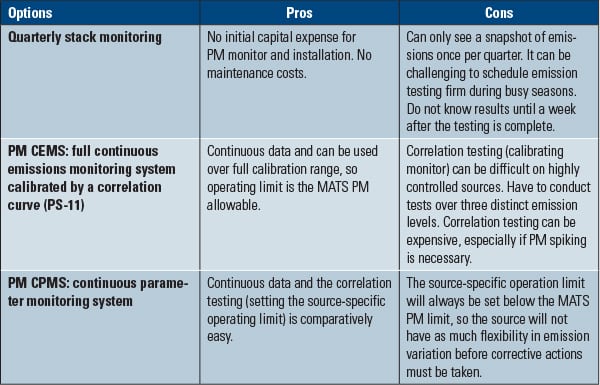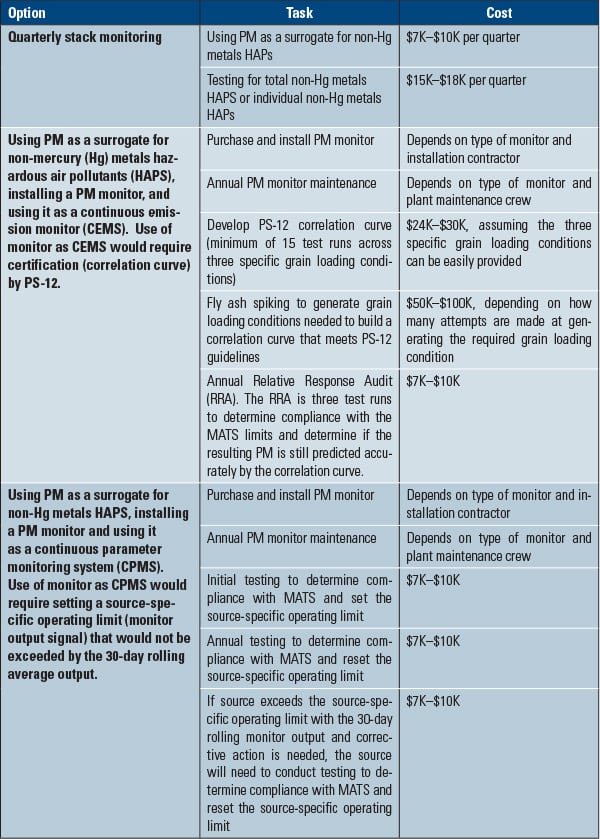Simplify MATS Compliance with Particulate Matter Continuous Emission Monitors
Now that power plant operators have some experience under their belts related to Mercury and Air Toxics Standards (MATS) compliance, it’s time to reevaluate the options for demonstrating compliance.
Starting with the Clean Air Act of 1970 and its updates, compliance for utility and industry stationary sources has only increased in complexity. The Environmental Protection Agency (EPA) has targeted many industries that emit criteria pollutants and hazardous air pollutants (HAPs) and has written regulations to ensure that affected industries control the release of pollutants by implementing the most effective control technologies.
Most recently, the Mercury and Air Toxics Standards, known as MATS, has been added to the list of regulations. MATS establishes emission limits for three HAP categories: mercury, non-mercury metals, and acid gases. Importantly, particulate matter (PM) is a surrogate for non-mercury metals.
This article focuses on the EPA’s requirement for Maximum Achievable Control Technology (MACT) as it applies to electric generating units (EGUs). An EGU must demonstrate compliance with the MATS limits, and MATS offers options for demonstrating compliance. An EGU can use continuous emission monitoring systems (CEMS) or a combination of CEMS and periodic testing using conventional reference methods. By understanding these options, source owners can implement strategies that allow facilities to set their source-specific operating limit closer to their PM compliance limit, which will help limit the risk of noncompliance.
MATS was promulgated in February 2012 and the industry had three years to demonstrate compliance (with a possible one-year extension in some cases). Coal- and oil-fired source operators had to analyze the regulations and define a strategy for mercury, non-mercury HAP metals, and acid gases compliance, based on the type of existing equipment they operated and the potential for add-on abatement equipment.
When considering non-mercury metal HAPs, the choice of PM as a surrogate simplified the strategy for many sources. Given that many PM monitor vendors were developing monitors to comply with this new regulation and historic data using PM monitors for compliance demonstration purposes in the U.S. was limited, many source owners defaulted to the quarterly PM stack testing option until PM monitor data, history, and resources could be researched.
Now, four years into the MATS compliance era, enough historic data and improved monitors exist to potentially change the PM compliance strategy to one that uses a PM monitor instead of quarterly PM stack testing.
CEMS vs. CPMS
To comply with the non-mercury HAP metals limits, an EGU can conduct quarterly manual reference method testing for metals or manual reference method testing for PM, the surrogate for non-mercury metal HAPs. Alternately, if the EGU chooses to use PM as a surrogate, it can install a continuous PM monitor and operate it as either a CEMS or a continuous parametric monitoring system (CPMS).
If the PM monitor is operated as CEMS, a correlation curve must be generated by statistically comparing CEMS data to reference method data as set forth in Performance Specification 11. If the PM monitor is operated as a CPMS, reference method PM testing is used to demonstrate compliance with the MATS PM limits at normal operation.
The response of the PM monitor that corresponds to this reference method PM testing is recorded and is considered to be the source-specific operating limit. As long as the 30-day rolling average output of the PM monitor stays below the source-specific operating limit, the source is considered in compliance with MATS for non-mercury metal HAPs using PM as a surrogate.
The Changing Role of Pollutant Monitors
Pollutant monitors play a critical role in demonstrating continuous compliance. These monitors, based on a range of analytical detection technologies, can qualify and quantify target compounds, and when quality assurance and maintenance procedures for the systems are defined, they can provide defensible emissions data.
Gaseous monitors are the most common CEMS, but recent technological advances have expanded the availability of PM monitors beyond those used to measure opacity. Importantly, modern PM monitors can express PM emissions as a concentration, thus allowing comparison to a PM emissions limit.
Here’s a condensed timeline of PM monitoring development:
■ 1950s and 1960s: The Germans pioneered and began studying PM detection technologies.
■ 1970s: PM technologies came to the U.S. in the form of opacity monitors. Opacity was considered a surrogate for PM and Performance Specification 1 (also known as PS1) was promulgated in 1975.
■ 1996: The Hazardous Waste Combustion MACT rule was the first to require the use of PM monitors. The need for a performance specification to validate PM monitor data was proposed (PS-11).
■ 1999: The Portland Cement MACT standard mandated PM monitors, but not until PS-11 was promulgated (2004).
■ 2012: MATS was promulgated, allowing certain PM CEMS detection technologies for filterable particulate matter (FPM) compliance demonstrations. The PM monitors could be used as a true PM CEMS or PM CPMS.
PM monitoring technologies include: light scattering, beta attenuation (the two most commonly deployed technologies), probe electrification, optical scintillation, and light extinction. From these measurement technologies and the diligent work of instrument vendors, today PM monitors can detect and indicate changes in the amount of FPM in exhaust gases and are accurate and durable enough to be utilized as CEMS.
Unlike traditional gaseous monitors, PM monitors cannot be calibrated like a CEMS that measures gaseous pollutants. Instead of using calibration gases, the monitor output signal must be correlated to a physical PM measurement that is obtained using an EPA reference method stack test for PM.
In general, the PM detection principle is a function of the size, shape, color, concentration, and material of the PM and is therefore source specific. Accordingly, PM monitors must be evaluated for each source over a range of operating conditions. Furthermore, PM monitors are different from traditional gaseous monitors.
It’s important to note that MATS allows choices in how the PM monitor can be used. When the regulation was first enacted, power companies had to quickly choose a compliance strategy. Among the choices were the use of a PM monitor as a full CEMS or the use of a PM monitor as a CPMS. Now, with the experience gained through various approaches, the time is right to revisit compliance demonstration strategies using continuous PM monitors as CEMS or CPMS.
Three Options
Table 1 details the three options for power plant operators to consider with respect to demonstrating compliance with the non-mercury metal HAP limit using PM as a surrogate.
 |
|
Table 1. Summary of PM measurement options. Source: TRC Companies Inc. |
Most have followed periodic manual testing or the use of a PM continuous monitor as a PM CEMS. But the time has come to take another look at the overlooked option of using a PM continuous monitor in a CPMS mode.
What’s needed to get started?
To begin, the facility must determine the PM limit from MATS. PM limits vary based on fuel type and whether the source is new or existing. MATS allows PM to be measured and reported in lb/MMBtu or lb/MWh, and the EGU should select the most favorable reporting option. The facility will then need to conduct performance testing using EPA Reference Methods to demonstrate compliance with the MATS PM emission limit.
The next step is to establish a source-specific operating limit. To do this, the facility will need to perform the following tasks:
■ Conduct a performance test.
■ Record all CPMS output values (milliamps or other signal).
■ Determine 1-hour average CPMS output readings (milliamps) during the performance test. (Note: If you perform three 3-hour test runs, you generate nine 1-hour CPMS averages.)
■ Set a source-specific operating limit based on these results.
■ Operate and maintain equipment to achieve a 30-day PM CPMS average that does not exceed the established operating limit. (MATS allows the monitor output signal that correlates to the highest 1-hour CPMS output for existing units only; for new EGUs it is the average output.)
■ Reset the source-specific operating limit annually.
The mechanism selected for determining the source-specific operating limit will depend on the results of the performance tests. Once again, the source has choices. Under MATS, if a PM monitor is being used as a CPMS, setting the source-specific operating limit is different for a new source than it is for an existing source. For a new source, if the performance tests indicate PM emissions are less than 75% of the MATS limit, the source-specific operating limit can be extrapolated to equal 75% of the MATS limit. Only new sources are eligible for this extrapolation.
If the performance test results are greater than or equal to 75% of the MACT limit, the average PM CPMS output value (milliamps) will be the source-specific operating limit.
If the 30-day rolling average output of the PM CPMS exceeds the source-specific operating limit, the source must take corrective actions as follows:
■ Within 48 hours of an exceedance, a visual inspection of the air pollution control device (APCD) must be performed. If the inspection identifies the cause, corrective action must be taken and the PM CPMS must be returned to operation.
■ Within 30 days of the exceedance, or at the time of the annual performance (compliance) tests, whichever comes first, a PM performance test must be conducted to demonstrate compliance with the PM MACT limit and to reestablish the source-specific operating limit.
■ The compliance demonstration and reset of the operating limit must be implemented within 45 days of the exceedance.
■ Additional testing is not required for any exceedance that occurs between the initial exceedance and the performance test triggered by that exceedance.
Before devising a strategy for setting source-specific operating limits make sure you:
■ Apply the proper PM MACT limit based on the source type.
■ Have an instrument that indicates the presence of and changes in PM in the exhaust.
■ Understand the ways to establish the PM CPMS operating limits.
■ Understand what triggers corrective action.
■ Understand how operational variables affect PM emissions (PM CPMS output).
■ Are aware that operating limits are reset every year or when an exceedance occurs.
Using measurement results and what’s known about the effects of unit operation on the CPMS output, source owners can develop a strategy for setting source-specific operating limits that provide the facility with the most flexibility to operate the source.
The strategy selected will depend on how close emissions are to the PM MATS limit under normal operations. As an example, the following scenarios could shape the strategy for setting the source-specific operating limit:
■ If the PM performance test results are above or equal to 75% of MACT limit (new or existing units), this is the operating limit. It may be useful to adjust operating parameters to produce PM emissions closer to the MATS limit.
■ If the PM performance test results are below but close or equal to 75% of MACT limit (new units only are candidates for extrapolation), there may be no benefit to extrapolating to 75%. It may be useful to adjust operating parameters to produce PM emissions closer to the MATS limit.
■ If the PM performance test results are well below the 75% of MACT limit, extrapolate to 75% (if the unit is a candidate) or adjust operating parameters to produce PM emissions closer to the MATS limits when setting the source-specific operating limit.
Many source owners set the source-specific operating limits near the MACT limit because it provides more room for operational variations, reduces the need for APCD maintenance, and can avoid costly corrective action exercises. But this can lead to complications.
For example, when annual compliance and operational limit reset time comes around, this strategy relies on being able to set the unit near the same emission rate (same monitor output) for each annual test. If the PM CPMS calibration (correlation between the monitor output and the actual PM emission rate) stays the same, this is not an issue, but if it changes, there is a chance that the facility will fail the performance test.
This strategy usually requires some in-house or preliminary PM testing to verify or confirm that the PM CPMS output as compared to actual PM emission limits is still accurate, especially if the target is a value very near the MACT limit.
Cost Comparison
In addition to compliance risk, it’s also important to understand the costs associated with each of the three approaches described. Table 2 provides a comparison of the three options for demonstrating compliance with the PM standard.
 |
|
Table 2. Range of costs for purchasing and maintaining PM systems. Source: TRC Companies Inc. |
Each of these approaches has advantages and disadvantages that must be considered when determining a MATS compliance strategy. Working with an expert air pollution monitoring firm allows fossil fuel–fired power generators to develop a compliance strategy based on sound measurement data. Prudent power generators will capitalize on the choice that the MATS regulations provide when determining compliance. The source can select a surrogate for a class of HAPs (acid gases and non-Hg HAP metal). The source can then choose if it wants to comply by using manual testing methods or a pollutant monitor and, in the case of using PM as a surrogate for non-Hg metals and using a PM monitor to demonstrate compliance, the owner can choose how to use the PM monitor—as a CEMS or a CPMS.
The success of any compliance strategy is proven over time. As more data are generated and operators understand how fuel variations and operating parameter changes affect the compliance status of a unit, the compliance approach and strategy for a facility will be refined.
The U.S. industrial and regulatory communities are investing heavily in the goal of reducing power plant HAP emissions through MATS. This investment and subsequent operating history may be creating the road map for other countries to accomplish the same goals. ■
—Rick Krenzke ([email protected]) is a project director in TRC Companies Inc.’s Air Measurement Services Practice in Austin, Texas.
